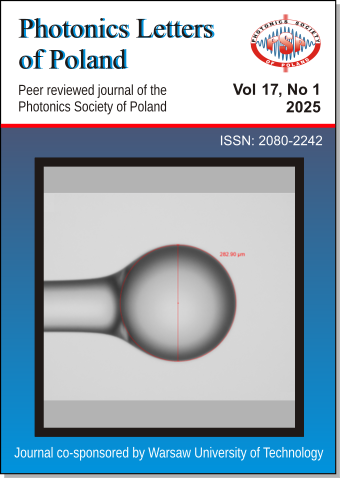Broadband emission in the near-infrared range in glasses doped with PbS quantum dots and Er3+ ions
DOI:
https://doi.org/10.4302/plp.v17i1.1322Abstract
This work presents borosilicate glasses co-doped with PbS quantum dots and Er3+ ions for broadband NIR luminescence. The heat- treatment increased the absorbance of glass in the visible range and shits absorption edge towards longer wavelengths. Glass co-doped with PbS/Er3+ after heat-treatment at 490°C showed broadband luminescence in 1-1.6 µm range under pumping at the wavelength of 980 nm. In the case of pumping at the wavelength of 808 nm, the obtained band was lower due to non-radiative processes and finally, lower intensity of Er3+ ions luminescence.
Full Text: PDF
References
- M.S. Dhlamini, G.H. Mhlongo, H.C. Swart, K.T. Hillie, "Energy transfer between doubly doped Er3+, Tm3+and Ho3+ rare earth ions in SiO2 nanoparticles", J. Lumin., 131(4), 790 (2011). CrossRef
- Z. Gao et al., "Selective doping of Ni2+ in highly transparent glass-ceramics containing nano-spinels ZnGa2O4 and Zn1+x Ga2−2x Ge x O4 for broadband near-infrared fiber amplifiers", Sci. Rep. 7(1), 1783 (2017). CrossRef
- M.A. Hughes, T. Suzuki, Y. Ohishi, "Spectroscopy of bismuth-doped lead–aluminum–germanate glass and yttrium–aluminum–silicate glass", J. Non-Cryst. Solids, 356(44–49), 2302 (2010). CrossRef
- X. Huang, Z. Peng, Q. Guo, X. Song, J. Qiu, G. Dong, "Energy transfer process and temperature‐dependent photoluminescence of PbS quantum dot‐doped glasses", J. Am. Ceram. Soc., 102(6), 3391 (2019). CrossRef
- N. Shasmal, W.J.G.J. Faria, A.S.S. de Camargo, A.C.M. Rodrigues, "Significant enhancement in Eu3+/Eu2+ emissions intensity by CdS quantum dots, in chloroborosilicate glasses", J. Lumin., 243, 118623 (2022). CrossRef
- Y. Yu, "Ultra-stable Eu3+-doped CsPbCl2Br1 perovskite quantum dots glass for optical temperature sensing", J. Rare Earths, 39(12), 1497 (2021). CrossRef
- E.O. Serqueira, N.O. Dantas, "Determination of the energy transfer section between CdS semiconductor quantum dots and Nd3+ ions", Opt. Mater., 90,252 (2019). CrossRef
- M.A. Kim, Y.K. Kwon, C. Liu, J. Heo, "Lead sulfide quantum dots in glasses containing rare-earth ions", J. Non-Cryst. Solids, 383, 173 (2014). CrossRef
- W.J. Park, C. Liu, J. Heo, "Direct Imaging of the Distribution of Nd3+ Ions in Glasses Containing PbS Quantum Dots", J. Am. Ceram. Soc., 98(7), 2074 (2015). CrossRef
- W. Wang et al., "PbS quantum dots and BaF2:Tm3+ nanocrystals co-doped glass for ultra-broadband near-infrared emission [Invited]", Chin. Opt. Lett., 20(2), 021603(2021). CrossRef
- W. Wang, Y. Xiao, B. Zhou, S. Xu, Q. Zhang, "Quantum-dots-precipitated rare-earth-doped glass for ultra-broadband mid-infrared emissions", J. Am. Ceram. Soc., 102(4), 1560 (2019). CrossRef
- D. Chen et al., "Broadband Optical Amplification of PbS Quantum-Dot-Doped Glass Fibers", Adv. Photonics Res., 3(9), 2200097 (2022). CrossRef
- C. Cheng, F. Wang, X. Cheng, "PbSe quantum-dot-doped broadband fiber amplifier based on sodium-aluminum-borosilicate-silicate glass", Opt. Laser Technol., 122, 105812 (2020). CrossRef
- T. Zha, P. Zhang, X, Jin, Y. Long, T. Huang, H. Jia, Z. Fang, B.O. Guan, "Glass Ceramic Fibers Containing PbS Quantum Dots for Fluorescent Temperature Sensing", Nanomaterials 14(10), 882 (2024). CrossRef
- N.A. Nabilah Razali et al., "The Physical and Optical Studies of Erbium Doped Borosilicate Glass", J. Phys. Conf. Ser., 1083(1), 012004 (2018). CrossRef
Downloads
Published
How to Cite
Issue
Section
License
Copyright (c) 2025 Jakub Markiewicz, Tomasz Ragiń, Marcin Kochanowicz

This work is licensed under a Creative Commons Attribution 4.0 International License.
Authors retain copyright and grant the journal right of first publication with the work simultaneously licensed under a Creative Commons Attribution License that allows others to share the work with an acknowledgement of the work's authorship and initial publication in this journal. Authors are able to enter into separate, additional contractual arrangements for the non-exclusive distribution of the journal's published version of the work (e.g., post it to an institutional repository or publish it in a book), with an acknowledgement of its initial publication in this journal. Authors are permitted and encouraged to post their work online (e.g., in institutional repositories or on their website) prior to and during the submission process, as it can lead to productive exchanges, as well as earlier and greater citation of published work (See The Effect of Open Access).




